|
MUTINY OF THE
ANUNNAKI
AFTER ENLIL ARRIVED on Earth in person, "Earth Command" was
transferred out of Enki's hands. It was probably at this point that
Enki's epithet or name was changed to E.A ("lord waters") rather
than "lord earth."
The Sumerian texts explain that at that early stage in the arrival
of the gods on Earth, a separation of powers was agreed upon: Anu
was to stay in the heavens and rule over the Twelfth Planet; Enlil
was to command the lands; and Enki was put in charge of the AB.ZU (apsu
in Akkadian).
Guided by the "watery" meaning of the name E.A,
scholars have translated AB.ZU as "watery deep," assuming that, as
in Greek mythology, Enlil represented the thundering Zeus, and Ea
was the prototype of Poseidon, God of the Oceans.
In other instances, Enlil's domain was referred to as the Upper
World, and Ea's as the Lower World; again, the scholars assumed that
the terms meant that Enlil controlled Earth's atmosphere while Ea
was ruler of the "subterranean waters" - the Greeklike Hades the
Mesopotamians supposedly believed in. Our own term abyss (which
derives from apsu) denotes deep, dark, dangerous waters in which one
can sink and disappear.
Thus, as scholars came upon Mesopotamian
texts describing this Lower World, they translated it as Unterwelt
("underworld") or Totenwelt ("world of the dead"). Only in recent
years have the Sumerologists mitigated the ominous connotation
somewhat by using the term netherworld in translation.
The Mesopotamian texts most responsible for this misinterpretation
were a series of liturgies lamenting the disappearance of Dumuzi,
who is better known from biblical and Canaanite texts as the god
Tammuz. It was with him that Inanna/Ishtar had her most celebrated
love affair; and when he disappeared, she went to the Lower World to
seek him.
The massive Tammuz-Liturgen und Verwandtes by P. Maurus Witzel, a
masterwork on the Sumerian and Akkadian "Tammuz texts," only helped
perpetuate the misconception. The epic tales of Ishtar's search were
taken to mean a journey "to the realm of the dead, and her eventual
return to the land of the living."
The Sumerian and Akkadian texts describing the descent of Inanna/Ishtar
to the Lower World inform us that the goddess decided to visit her
sister Ereshkigal, mistress of the place.
Ishtar went there neither
dead nor against her will - she went alive and uninvited, forcing
her way in by threatening the gatekeeper:
If thou openest not the gate so that I cannot enter,
I will smash the door, I will shatter the bolt,
I will smash the doorpost, I will move the doors.
One by one, the seven gates leading to the abode of Ereshkigal were
opened to Ishtar; when she finally made it, and Ereshkigal saw her,
she literally blew her top (the Akkadian text says, "burst at her
presence").
The Sumerian text, vague about the purpose of the trip
or the cause of Ereshkigal's anger, reveals that Inanna expected
such a reception. She took pains to notify the other principal
deities of her journey in advance, and made sure that they would
take steps to rescue her in case she was imprisoned in the "Great
Below."
The spouse of Ereshkigal - and Lord of the Lower World - was Nergal.
The manner in which he arrived in the Great Below and became its
lord not only illuminates the human nature of the "gods" but also
depicts the Lower World as anything but a "world of the dead."
The tale, found in several versions, begins with a banquet at which
the guests of honor were Anu, Enlil, and Ea. The banquet was held
"in the heavens," but not at Anu's abode on the Twelfth Planet.
Perhaps it took place aboard an orbiting spacecraft, for when
Ereshkigal could not ascend to join them, the gods sent her a
messenger who "descended the long staircase of the heavens, reached
the gate of Ereshkigal."
Having received the invitation, Ereshkigal
instructed her counselor, Namtar:
"Ascend, Namtar, the long staircase of the heavens; Remove the dish
from the table, take my share; Whatever Anu gives to thee, bring it
all to me."
When Namtar entered the banquet hall, all the gods except "a bald
god, seated in the back," rose to greet him. Namtar reported the
incident to Ereshkigal when he returned to the Lower World. She and
all the lesser gods of her domain were insulted. She demanded that
the offending god be sent to her for punishment.
The offender, however, was Nergal, a son of the great Ea. After a
severe reprimand by his father, Nergal was instructed to make the
trip alone, armed only with lots of fatherly advice on how to
behave. When Nergal arrived at the gate, he was recognized by Namtar
as the offending god and led in to "Ereshkigal's wide courtyard,"
where he was put to several tests.
Sooner or later, Ereshkigal went to take her daily bath.
...she revealed her body.
What is normal for man and woman,
he ... in his heart...
...they embraced,
... they got into bed.
For seven days and nights they made love.
In the Upper World, an
alarm had gone out for the missing Nergal.
"Release me," he said to Ereshkigal. "I will go, and I will come back," he promised.
But no
sooner had he left than Namtar went to Ereshkigal and accused Nergal
of having no intention of coming back.
Once more Namtar was sent up
to Anu. Ereshkigal's message was clear:
I, thy daughter, was young;
I have not known the play of maidens...
That god whom you didst send,
and who had intercourse with me -
Send him to me, that he may be my husband,
That he might lodge with me.
With married life perhaps not yet on his mind, Nergal organized a
military expedition and stormed the gates of Ereshkigal, intending
to "cut off her head."
But Ereshkigal pleaded:
"Be thou my husband and I will be thy wife.
I will let thee hold dominion
over the wide Lower Land.
I will place the Tablet of Wisdom in thy hand.
Thou shalt be Master, I will be Mistress."
And then came the happy ending:
When Nergal heard her words,
He took hold of her hand and kissed her,
Wiping away her tears:
"What thou hast wished for me
since months past - so be it now!"
The events recounted do not suggest a Land of the Dead. Quite the
contrary: It was a place the gods could enter and leave, a place of
lovemaking, a place important enough to be entrusted to a
granddaughter of Enlil and a son of Enki.
Recognizing that the facts
do not support the earlier notion of a dismal region, W. F. Albright
(Mesopotamian Elements in Canaanite Eschatology) suggested that Dumuzi's abode in the Lower World was "a bright and fruitful home in
the subterranean paradise called 'the mouth of the rivers' which was
closely associated with the home of Ea in the Apsu.”
The place was far and difficult to reach, to be sure, and a somewhat
"restricted area,*' but hardly a "place of no return." Like Inanna,
other leading deities were reported going to, and returning from,
this Lower World. Enlil was banished to the Abzu for a while, after
he had raped Ninlil. And Ea was a virtual commuter between Eridu in
Sumer and the Abzu, bringing to the Abzu "the craftsmanship of Eridu"
and establishing in it "a lofty shrine" for himself.
Far from being a dark and desolate place, it was described as a
bright place with flowing waters.
A rich land, beloved of Enki;
Bursting with riches, perfect in fullness...
Whose mighty river rushes across the land.
We have seen the many depictions of Ea as the God of Flowing Waters.
It is evident from Sumerian sources that such flowing waters indeed
existed - not in Sumer and its flatlands, but in the Great Below. W.
F. Albright drew attention to a text dealing with the Lower World as
the Land of UT.TU - "in the west" of Sumer. It speaks of a journey
of Enki to the Apsu:
To thee, Apsu, pure land, Where great waters rapidly flow, To the
Abode of Flowing Waters The Lord betakes himself.... The Abode of
Flowing Waters Enki in the pure waters established; In the midst of
the Apsu, A great sanctuary he established.
By all accounts, the place lay beyond a sea. A lament for "the pure
son," the young Dumuzi, reports that he was carried off to the Lower
World in a ship. A "Lamentation over the Destruction of Sumer"
describes how Inanna managed to sneak aboard a waiting ship. "From
her possessions she sailed forth. She descends to the Lower World."
A long text, little understood because no intact version has been
found, deals with some major dispute between Ira (Nergal's title as
Lord of the Lower World) and his brother Marduk. In the course of
the dispute, Nergal left his domain and confronted Marduk in
Babylon; Marduk, on the other hand, threatened: "To the Apsu will I
descend, the Anunnaki to supervise... my raging weapons against
them I will raise." To reach the Apsu, he left the Land of
Mesopotamia and traveled over "waters that rose up."
His destination
was Arali in the "basement" of Earth, and the texts provide a
precise clue as to where this "basement" was:
In the distant sea,
100 beru of water [away]...
The ground of Arali [is]...
It is where the Blue Stones cause ill,
Where the craftsman of Anu
the Silver Axe carries, which shines as the day.
The beru, both a land-measuring and a time-reckoning unit, was
probably used in the latter capacity when travel over water was
involved.
As such it was a double hour, so that one hundred beru
meant two hundred hours of sailing. We have no way of determining
the assumed or average sailing speed employed in these ancient
distance reckonings. But there is no doubt that a truly distant land
was reached after a sea voyage of over two or three thousand miles.
The texts indicate that Arali was situated west and south of Sumer.
A ship traveling two to three thousand miles in a southwesterly
direction from the Persian Gulf could have only one destination: the
shores of southern Africa.
Only such a conclusion can explain the terms Lower World, as meaning
the southern hemisphere, where the Land of Arali was, as contrasted
with the Upper World, or northern hemisphere, where Sumer was. Such
a division of Earth's hemispheres between Enlil (northern) and Ea
(southern) paralleled the designation of the northern skies as the
Way of Enlil and the southern skies as the Way of Ea.
The ability of the Nefilim to undertake interplanetary travel, orbit
Earth, and land on it should obviate the question whether they could
possibly have known of southern Africa, besides Mesopotamia. Many
cylinder seals, depicting animals peculiar to the area (such as the
zebra or ostrich), jungle scenes, or rulers wearing leopard skins in
the African tradition, attest to an "African connection."
What interest did the Nefilim have in this part of Africa, diverting
to it the scientific genius of Ea and granting to the important gods
in charge of the land a unique "Tablet of Wisdom"?
The Sumerian term AB.ZU, which scholars have accepted to mean
"watery deep," requires a fresh and critical analysis. Literally,
the term meant "primeval deep source" - not necessarily of waters.
According to Sumerian grammatical rules, either of two syllables of
any term could precede the other without changing the word's
meaning, with the result that AB.ZU and ZU.AB meant the same thing.
The latter spelling of the Sumerian term enables identification of
its parallel in the Semitic languages, for za-ab has always meant
and still means "precious metal," specifically "gold," in Hebrew and
its sister languages.
The Sumerian pictograph for AB.ZU was that of an excavation deep
into Earth, mounted by a shaft.
Thus, Ea was not the lord of an
indefinite "watery deep," but the god in charge of the exploitation
of Earth's minerals!
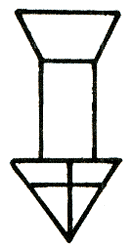
In fact, the Greek abyssos, adopted from the Akkadian apsu, also
meant an extremely deep hole in the ground.
Akkadian textbooks
explained that "apsu is nikbu"; the meaning of the word and that of
its Hebrew equivalent nikba is very precise: a deep, man-made
cutting or drilling into the ground.
P. Jensen (Die Kosmologie der Babylonier) observed back in 1890 that
the oft-encountered Akkadian term Bit Nimiku should not be
translated as "house of wisdom" but as "house of deepness." He
quoted a text (V.R.30, 49 - 50ab) that stated:
"It is from Bit Nimiku that gold and silver come."
Another text (III.R.57, 35ab), he
pointed out, explained that the Akkadian name "Goddess Shala of
Nimiki" was the translation of the Sumerian epithet "Goddess Who
Hands the Shining Bronze." The Akkadian term nimiku, which has been
translated as "wisdom," Jensen concluded, "had to do with metals."
But why, he admitted simply, "I do not know."
Some Mesopotamian hymns to Ea exalt him as Bel Nimiki, translated
"lord of wisdom"; but the correct translation should undoubtedly be
"lord of mining.'' Just as the Tablet of Destinies at Nippur
contained orbital data, it follows that the Tablet of Wisdom
entrusted to Nergal and Ereshkigal was in fact a "Tablet of Mining,"
a "data bank" pertaining to the mining operations of the Nefilim.
As Lord of the Abzu, Ea was assisted by another son, the god GI.BIL
("he who burns the soil"), who was in charge of fire and smelting.
Earth's Smith, he was usually depicted as a young god whose
shoulders emit red-hot rays or sparks of fire, emerging from the
ground or about to descend into it.
The texts state that Gibil was
steeped by Ea in "wisdom," meaning that Ea had taught him mining
techniques.
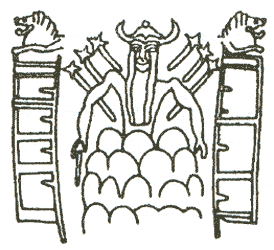
The metal ores mined in southeastern Africa by the Nefilim were
carried back to Mesopotamia by specially designed cargo ships called
MA.GUR UR.NU AB.ZU ("ship for ores of the Lower World").
There, the
ores were taken to Bad-Tibira, whose name literally meant "the
foundation of metalworking." Smelted and refined, the ores were cast
into ingots whose shape remained unchanged throughout the ancient
world for millennia.
Such ingots were actually found at various Near
Eastern excavations, confirming the reliability of the Sumerian
pictographs as true depictions of the objects they "wrote" out; the
Sumerian sign for the term ZAG ("purified precious") was the picture
of such an ingot.
In earlier times it apparently had a hole running
through its length, through which a carrying rod was inserted.
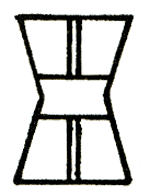
Several depictions of a God of the Flowing Waters show him flanked
by bearers of such precious metal ingots, indicating that he was
also the Lord of Mining.
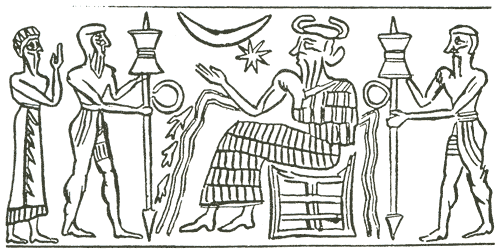
The various names and epithets for Ea's African Land of Mines are
replete with clues to its location and nature. It was known as
A.RA.LI ("place of the shiny lodes"), the land from which the metal
ores come.
Inanna, planning her descent to the southern hemisphere,
referred to the place as the land where "the precious metal is
covered with soil" - where it is found underground. A text reported
by Erica Reiner, listing the mountains and rivers of the Sumerian
world, stated: "Mount Arali: home of the gold"; and a fragmented
text described by H. Radau confirmed that Arali was the land on
which Bad-Tibira depended for its continued operations.
The Mesopotamia!! texts spoke of the Land of Mines as mountainous,
with grassy plateaus and steppes, and lush with vegetation. The
capital of Ereshkigal in that land was described by the Sumerian
texts as being in the GAB. KUR.RA ("in the chest of the mountains"),
well inland.
In the Akkadian version of Ishtar's journey, the
gatekeeper welcomes her:
Enter my lady,'
Let Kutu rejoice over thee;
Let the palace of the land of Nugia
Be glad at thy presence.
Conveying in Akkadian the meaning "that which is in the heartland,"
the term KU.TU in its Sumerian origin also meant "the bright
uplands."
It was a land, all texts suggest, with bright days, awash
with sunshine. The Sumerian terms for gold (KU.GI - "bright out of
earth") and silver (KU.BABBAR - "bright gold") retained the original
association of the precious metals with the bright (ku) domain of
Ereshkigal.
The pictographic signs employed as Sumer's first writing reveal
great familiarity not only with diverse metallurgical processes but
also with the fact that the sources of the metals were mines dug
down into the earth.
The terms for copper and bronze
("handsome-bright stone"), gold ("the supreme mined metal"), or
"refined" ("bright-purified") were all pictorial variants of a mine
shaft ("opening/mouth for dark-red" metal).
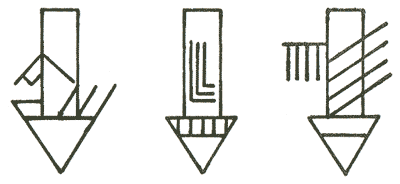
The land's name - Arali - could also be written as a variant of the
pictograph for "dark-red" (soil), of Rush ("dark-red," but in time
meaning "Negro"), or of the metals mined there; the pictographs
always depicted variants of a mine shaft.
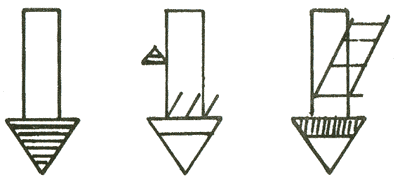
Extensive references to gold and other metals in ancient texts
suggest familiarity with metallurgy from the earliest times.
A
lively metals trade existed at the very beginnings of civilization,
the result of knowledge bequeathed to Mankind by the gods, who, the
texts state, had engaged in mining and metallurgy long before Man's
appearance. Many studies that correlate Mesopotamian divine tales
with the biblical pre-Diluvial list of patriarchs point out that,
according to the Bible, Tubal-cain was an "artificer of gold and
copper and iron" long before the Deluge.
The Old Testament recognized the land of Ophir, which was probably
somewhere in Africa, as a source of
gold in antiquity. King Solomon's ship convoys sailed down the Red
Sea from Ezion-geber (present-day Elath).
"And they went to Ophir
and fetched from thence gold."
Unwilling to risk a delay in the
construction of the Lord's Temple in Jerusalem, Solomon arranged
with his ally, Hiram, king of Tyre, to sail a second fleet to Ophir
by an alternate route:
And the king had at sea a navy of Tarshish.
with the navy of Hiram.
Once every three years came the navy of Tarshish,
bringing gold and silver, ivory and apes and monkeys.
The fleet of Tarshish took three years to complete a round trip.
Allowing for an appropriate time to load up at Ophir, the voyage in
each direction must have lasted well over a year.
This suggests a
route much more roundabout than the direct route via the Red Sea and
the Indian Ocean - a route around Africa.
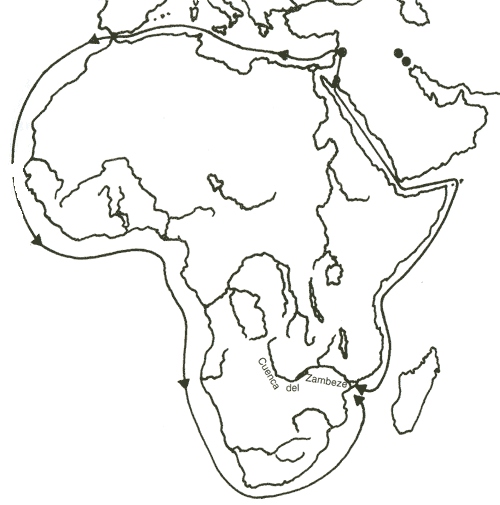
Most scholars locate Tarshish in the western Mediterranean, possibly
at or near the present Strait of Gibraltar.
This would have been an
ideal place from which to embark on a voyage around the African
continent. Some believe that the name Tarshish meant "smeltery."
Many biblical scholars have suggested that Ophir should be
identified with present-day Rhodesia. Z. Herman (Peoples, Seas,
Ships) brought together evidence showing that the Egyptians obtained
various minerals from Rhodesia in earliest times. Mining engineers
in Rhodesia as well as in South Africa have often searched for gold
by seeking evidence of prehistoric mining.
How was the inland abode of Ereshkigal reached? How were the ores
transported from the "heartland" to the coastal ports?
Knowing of
the reliance of the Nefilim on river shipping, one should not be
surprised to find a major, navigable river in the Lower World. The
tale of "Enlil and Ninlil" informed us that Enlil was banished to
exile in the Lower World. When he reached the land, he had to be
ferried over a wide river.
A Babylonian text dealing with the origins and destiny of Mankind
referred to the river of the Lower World as the River Habur, the
"River of Fishes and Birds." Some Sumerian texts nicknamed the Land
of Ereshkigal the "Prairie Country of HA.BUR."
Of the four mighty rivers of Africa, one, the Nile, flows north into
the Mediterranean; the Congo and Niger empty into the Atlantic Ocean
on the west; and the Zambezi flows from the heartland of Africa in
an eastward semicircle until it reaches the east coast. It offers a
wide delta with good port sites; it is navigable inland over a
distance of hundreds of miles.
Was the Zambezi the "River of Fishes and Birds" of the Lower World?
Were its majestic Victoria Falls the water-lulls mentioned in one
text as the site of Ereshkigal's capital?
Aware that many "newly discovered" and promising mining sites in
southern Africa had been mining sites in antiquity, the
Anglo-American Corporation called in teams of archaeologists to
examine the sites before modern earth-moving equipment swept away
all traces of ancient work. Reporting on their findings in the
magazine Optima, Adrian Boshier and Peter Beaumont stated that they
had come upon layers upon layers of ancient and prehistoric mining
activities and human remains.
Carbon dating at Yale University and
at the University of Groningen (Holland) established the age of the
artifacts as ranging from a plausible 2000 B.C. to an amazing 7690
B.C.
Intrigued by the unexpected antiquity of the finds, the team
extended its area of search. At the base of a cliff face on the
precipitous western slopes of Lion Peak, a five-ton slab of hematite
stone blocked access to a cavern. Charcoal remains dated the mining
operations within the cavern at 20,000 to 26,000 B.C.
Was mining for metals possible during the Old Stone Age?
Incredulous, the scholars dug a shaft at a point where, apparently,
the ancient miners had begun their operations. A charcoal sample
found there was sent to the Groningen laboratory. The result was a
dating of 41,250 B.C., give or take 1,600 years!
South African scientists then probed prehistoric mine sites in
southern Swaziland. Within the uncovered mine caverns, they found
twigs, leaves, and grass, even feathers - all, presumably, brought
in by the ancient miners as bedding. At the 35,000 B.C. level, they
found notched bones, which "indicate man's ability to count at that
remote period." Other remains advanced the age of the artifacts to
about 50,000 B.C.
Believing that the,
"true age of the onset of mining in Swaziland is
more likely to be in the order of 70,000-80,000 B.C.," the two
scientists suggested that "southern Africa... could well have
been in the forefront of technological invention and innovation
during much of the period subsequent to 100,000 B.C."
Commenting on the discoveries, Dr. Kenneth Oakley, former head
anthropologist of the Natural History Museum in London, saw quite a
different significance to the finds. "It throws important light on
the origins of Man ... it is now possible that southern Africa was
the evolutionary home of Man," the "birthplace" of Homo sapiens.
As we shall show, it was indeed there that modern Man appeared on
Earth, through a chain of events triggered by the gods' search for
metals.
Both serious scientists and science-fiction writers have suggested
that a good reason for us to establish settlements on other planets
or asteroids might be the availability of rare minerals on those
celestial bodies, minerals that might he too scarce or too costly to
mine on Earth.
Could this have been the Nefilim's purpose in
colonizing Earth?
Modern scholars divide Man's activities on Earth into the Stone Age,
Bronze Age, Iron Age, and so on; in ancient times, however, the
Greek poet Hesiod, for example, listed five ages - Golden, Silver,
Bronze, Heroic, and Iron. Except for the Heroic Age, all ancient
traditions accepted the sequence of gold-silver-copper - iron.
The
prophet Daniel had a vision in which he saw "a great image" with a
head of fine gold, breast and arms of silver, belly of brass, legs
of iron, and extremities, or feet, of clay.
Myth and folklore abound with hazy memories of a Golden Age, mostly
associated with the time when gods roamed Earth, followed by a
Silver Age, and then the ages when gods and men shared Earth - the
Age of Heroes, of Copper, Bronze, and Iron. Are these legends in
fact vague recollections of actual events on Earth?
Gold, silver, and copper are all native elements of the gold group.
They fall into the same family in the periodic classification by
atomic weight and number; they have similar crystallographic,
chemical, and physical properties - all are soft, malleable, and
ductile. Of all known elements, these are the best conductors of
heat and electricity.
Of the three, gold is the most durable, virtually indestructible.
Though best known for its use as money and in jewelry or fine
artifacts, it is almost invaluable in the electronics industry. A
sophisticated society requires gold for microelectronic assemblies,
guidance circuitry, and computer "brains."
Man's infatuation with gold is traceable to the beginnings of his
civilization and religion - to his contacts with the
ancient gods. The gods of Sumer required that they be served food
from golden trays, water and wine from golden vessels, that they be
clad in golden garments. Though the Israelites left Egypt in such a
hurry that there was no time for them to let their bread leaven,
they were ordered to ask the Egyptians for all available silver and
gold objects. This command, as we shall find out later, anticipated
the need for such materials to construct the Tabernacle and its
electronic accoutrements.
Gold, which we call the royal metal, was in fact the metal of the
gods. Speaking to the prophet Haggai, the Lord made it clear, in
connection with his return to judge the nations: "The silver is mine
and the gold is mine."
The evidence suggests that Man's own infatuation with these metals
has its roots in the great need of the Nefilim for gold.
The Nefilim,
it appears, came to Earth for gold and its related metals. They may
also have come for other rare metals - such as platinum (abundant in
southern Africa), which can power fuel cells in an extraordinary
manner. And the possibility should not be ruled out that they came
to Earth for sources of radioactive minerals, such as uranium or
cobalt - the Lower World's "blue stones that cause ill," which some
texts mention.
Many depictions show Ea - as the God of Mining -
emitting such powerful rays as he exits from a mine that the gods
attending him have to use screening shields; in all these
depictions, Ea is shown holding a miner's rock saw.
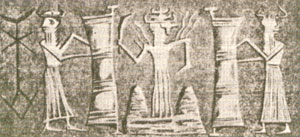
Though Enki was in charge of the first landing party and the
development of the Abzu, credit for what was accomplished - as the
case should be with all generals - should not go to him alone.
Those
who actually did the work, day in, day out, were the lesser members
of the landing party, the Anunnaki.
A Sumerian text describes the construction of Enlil's center in
Nippur. "The Annuna, gods of heaven and earth, are working. The axe
and the carrying-basket, with which they laid foundation of the
cities, in their hands they held."
The ancient texts described the Anunnaki as the rank-and-file gods
who had been involved in the settlement of Earth - the gods "who
performed the tasks." The Babylonian "Epic of Creation" credited
Marduk with giving the Anunnaki their assignments. (The Sumerian
original, we can safely assume, named Enlil as the god who commanded
these astronauts.)
Assigned to Anu, to heed his instructions,
Three hundred in the heavens he stationed as a guard;
the ways of Earth to define from the Heaven;
And on Earth,
Six hundred he made reside.
After he all their instructions had ordered,
to the Anunnaki of Heaven and of Earth
he allotted their assignments.
The texts reveal that three hundred of them - the "Anunnaki of
Heaven," or Igigi - were true astronauts who stayed aboard the
spacecraft without actually landing on Earth. Orbiting Earth, these
spacecraft launched and received the shuttlecraft to and from Earth.
As chief of the "Eagles," Shamash was a welcome and heroic guest
aboard the "mighty great chamber in heaven" of the Igigi. A "Hymn to
Shamash" describes how the Igigi observed Shamash approaching in his
shuttlecraft:
At thy appearances, all the princes are glad;
All the Igigi rejoice
over thee...
In the brilliance of thy light, their path...
They constantly look for thy radiance...
Opened wide is the doorway, entirely...
The bread offerings of all the Igigi [await thee].
Staying aloft, the Igigi were apparently never encountered by
Mankind.
Several texts say that they were "too high up for Mankind,"
as a consequence of which "they were not concerned with the people."
The Anunnaki, on the other hand, who landed and stayed on Earth,
were known and revered by Mankind.
The texts that state that "the
Anunnaki of Heaven... are 300" also state that "the Anunnaki of
Earth... are 600."
Still, many texts persist in referring to the Anunnaki as the "fifty
great princes." A common spelling of their name in Akkadian, An-nun-na-ki,
readily yields the meaning "the fifty who went from Heaven to
Earth." Is there a way to bridge the seeming contradiction?
We recall the text relating how Marduk rushed to his father Ea to
report the loss of a spacecraft carrying "the Anunnaki who are
fifty" as it passed near Saturn. An exorcism text from the time of
the third dynasty of Ur speaks of the anunna eridu ninnubi ("the
fifty Anunnaki of the city Eridu"). This strongly suggests that the
group of Nefilim who founded Eridu under the command of Enki
numbered fifty.
Could it be that fifty was the number of Nefilim in
each landing party?
It is, we believe, quite conceivable that the Nefilim arrived on
Earth in groups of fifty. As the visits to Earth became regular,
coinciding with the opportune launching times from the Twelfth
Planet, more Nefilim would arrive. Each time, some of the earlier
arrivals would ascend in an Earth module and rejoin the spaceship
for a trip home. But, each time, more Nefilim would stay on Earth,
and the number of Twelfth Planet astronauts who stayed to colonize
Earth grew from the initial landing party of fifty to the "600 who
on Earth settled."
How did the Nefilim expect to achieve their mission - to mine on
Earth its desired minerals, and ship the ingots back to the Twelfth
Planet - with such a small number of hands?
Undoubtedly, they relied on their scientific knowledge. It was there
that Enki's full value becomes clear - the reason for his, rather
than Enlil's, being the first to land, the reason for his assignment
to the Abzu.
A famous seal now on exhibit at the Louvre Museum shows Ea with his
familiar flowing waters, except that the waters seem to emanate
from, or be filtered through, a series of laboratory flasks.
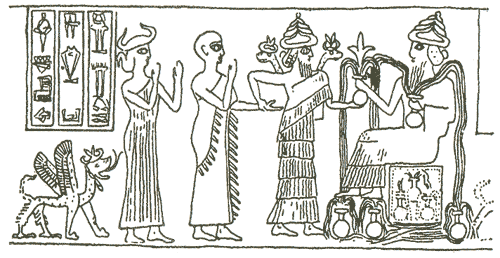
Such an
ancient interpretation of Ea's association with waters raises the
possibility that the original hope of the Nefilim was to obtain
their minerals from the sea.
The oceans' waters do contain vast
quantities of gold and other vital minerals, but so greatly diluted
that highly sophisticated and cheap techniques are needed to justify
such "water mining." It is also known that the sea beds contain
immense quantities of minerals in the form of plum-sized nodules -
available if only one could reach deep down and scoop them up.
The ancient texts refer repeatedly to a type of ship used by the
gods called elippu tebiti ("sunken ship" - what we now call a
submarine). We have seen the "fish-men" that were assigned to Ea. Is
this evidence of efforts to dive to the depths of the oceans and
retrieve their mineral riches? The Land of the Mines, we have noted,
was earlier called A.RA.LI. - "place of the waters of the shiny
lodes."
This could mean a land where gold could be river-panned; it
could also refer to efforts to obtain gold from the seas.
If these were the plans of the Nefilim, they apparently came to
naught. For, soon after they had established their first
settlements, the few hundred Anunnaki were given an unexpected and
most arduous task: to go down into the depths of the African soil
and mine the needed minerals there.
Depictions that have been found on cylinder seals show gods at what
appear to be mine entrances or mine shafts; one shows Ea in a land
where Gibil is aboveground and another god toils underground, on his
hands and knees.
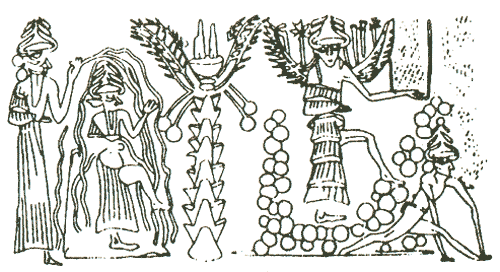
In later times, Babylonian and Assyrian texts disclose, men - young
and old - were sentenced to hard labor in the mines of the Lower
World.
Working in darkness and eating dust as food, they were doomed
never to return to their homeland. This is why the Sumerian epithet
for the land - KUR.NU.GI.A - acquired the interpretation "land of no
return"; its literal meaning was "land where gods-who-work, in deep
tunnels pile up [the ores]."
For the time when the Nefilim settled
Earth, all the ancient sources attest, was a time when Man was not
yet on Earth; and in the absence of Mankind, the few Anunnaki had to
toil in the mines. Ishtar, on her descent to the Lower World,
described the toiling Anunnaki as eating food mixed with clay and
drinking water fouled with dust.
Against this background, we can fully understand a long epic text
named (after its opening verse, as was the custom), "When the gods,
like men, bore the work."
Piecing together many fragments of both Babylonian and Assyrian
versions, W. G. Lambert and A. R. Millard (Atra-Hasis: The
Babylonian Story of the Flood) were able to present a continuous
text. They reached the conclusion that it was based on earlier
Sumerian versions, and possibly on even earlier oral traditions
about the arrival of the gods on Earth, the creation of Man, and his
destruction by the Deluge.
While many of the verses hold only literary value to their
translators, we find them highly significant, for they corroborate
our findings and conclusions in the preceding chapters. They also
explain the circumstances that led to the mutiny of the Anunnaki.
The story begins in the time when only the gods lived on Earth:
When the gods, like men,
bore the work and suffered the toil -
the toil of the gods was great,
the work was heavy,
the distress was much.
At that time, the epic relates, the chief deities had already
divided the commands among themselves.
Anu, father of the Anunnaki, was their Heavenly King;
Their Lord Chancellor was the warrior Enlil.
Their Chief Officer was Ninurta,
And their Sheriff was Ennugi.
The gods had clasped hands together,
Had cast lots and divided.
Anu had gone up to heaven,
[Left] the earth to his subjects.
The seas, enclosed as with a loop,
They had given to Enki, the prince.
Seven cities were established, and the text refers to seven Anunnaki
who were city commanders.
Discipline must have been strict, for the
text tells us,
"The seven Great Anunnaki were making the lesser gods
suffer the work."
Of all their chores, it seems, digging was the most common, the most
arduous, and the most abhorred.
The lesser gods dug up the river
beds to make them navigable; they dug canals for irrigation; and
they dug in the Apsu to bring up the minerals of Earth. Though they
undoubtedly had some sophisticated tools - the texts spoke of the
"silver axe which shines as the day," even underground - the work
was too exacting.
For a long time - for forty "periods," to be exact
- the Anunnaki "suffered the toil"; and then they cried: No more!
They were complaining, backbiting,
Grumbling in the excavations.
The occasion for the mutiny appears to have been a visit by Enlil to
the mining area.
Seizing the opportunity, the Anunnaki said to one
another:
Let us confront our... the Chief Officer,
That he may relieve us
of our heavy work.
The king of the gods, the hero Enlil,
Let us
unnerve him in his dwelling!
A leader or organizer of the mutiny was soon found. He was the
"chief officer of old time," who must have held a grudge against the
current chief officer. His name, regrettably, is broken off; but his
inciting address is quite clear:
"Now, proclaim war;
Let us combine hostilities and battle."
The description of the mutiny is so vivid that scenes of the
storming of the Bastille come to mind:
The gods heeded his words.
They set fire to their tools;
Fire to their axes they put;
They troubled the god of mining in the tunnels;
They held [him] as they went
to the gate of the hero Enlil.
The drama and tension of the unfolding events are brought to life by
the ancient poet:
It was night, half-way through the watch.
His house was surrounded -
but the god, Enlil, did not know.
Kalkal [then] observed it, was disturbed.
He slid the bolt and watched....
Kalkal roused Nusku;
they listened to the noise of. ...
Nusku roused his lord -
he got him out of his bed, [saying]:
"My lord, your house is surrounded,
battle has come right up to your gate."
Enlil's first reaction was to take up arms against the mutineers.
But Nusku, his chancellor, advised a Council of the Gods:
"Transmit a message that Anu come down;
Have Enki brought to your presence."
He transmitted and Anu was carried down;
Enki was also brought to his presence.
With the great Anunnaki present,
Enlil arose... opened his mouth
And addressed the great gods.
Taking the mutiny personally, Enlil demanded to know:
"Is it against me that this is being done?
Must I engage in hostilities... ?
What did my very own eyes see?
That battle has come right up to my gate!"
Anu suggested that an inquiry be undertaken.
Armed with the
authority of Anu and the other commanders, Nusku went to the
encamped mutineers.
"Who is the instigator of battle?" he asked.
"Who is the provoker of hostilities?"
The Anunnaki stood together:
"Every single one of us gods has war
declared! We have our ... in the excavations; Excessive toil has
killed us, Our work was heavy, the distress much."
When Enlil heard Nusku's report of these grievances, "his tears
flowed." He presented an ultimatum: either the leader of the
mutineers be executed or he would resign.
"Take the office away,
take back your power," he told Anu, "and I will to you in heaven
ascend."
But Ami, who came down from Heaven, sided with the
Anunnaki:
"What are we accusing them of?
Their work was heavy, their distress was much!
Every day...
The lamentation was heavy, we could hear the complaint."
Encouraged by his father's words, Ea also "opened his mouth" and
repeated Anu's summation. But he had a solution to offer: Let a
lulu, a "Primitive Worker," be created!
"While the Birth Goddess is present, Let her create a Primitive
Worker; Let him bear the yoke.... Let him carry the toil of the
gods!"
The suggestion that a "Primitive Worker" be created so that he could
take over the burden of work of the Anunnaki was readily accepted.
Unanimously, the gods voted to create "The Worker."
" 'Man shall be
his name," they said:
They summoned and asked the goddess,
The midwife of the gods, the wise Mami,
[and said to her:]
"You are the Birth Goddess, create Workers!
Create a Primitive Worker,
That he may bear the yoke!
Let him bear the yoke assigned by Enlil,
Let The Worker carry the toil of the gods!"
Mami, the Mother of the Gods, said she would need the help of Ea,
"with whom skill lies." In the House of Shimti, ;i hospital-like
place, the gods were waiting. Ea helped prepare the mixture from
which the Mother Goddess proceeded to fashion "Man." Birth goddesses
were present. The Mother Goddess went on working while incantations
were constantly recited.
Then she shouted in triumph:
"I have created!
My hands have made it!"
She "summoned the Anunnaki, the Great Gods... she opened her
mouth, addressed the Great Gods":
"You commanded me a task -
I have completed it. ...
I have removed your heavy work
I have imposed your toil on The Worker, 'Man.'
You raised a cry for a Worker-kind:
I have loosed the yoke,
I have provided your freedom."
The Anunnaki received her announcement enthusiastically.
"They ran
together and kissed her feet."
From then on it would be the
Primitive Worker - Man - "who will bear the yoke."
The Nefilim, having arrived on Earth to set up their colonies, had
created their own brand of slavery, not with slaves imported from
another continent, but with Primitive Workers fashioned by the
Nefilim themselves.
A mutiny of the gods had led to the creation of Man.
Return to Contents
Return to Gold for Humans and Others...
|









